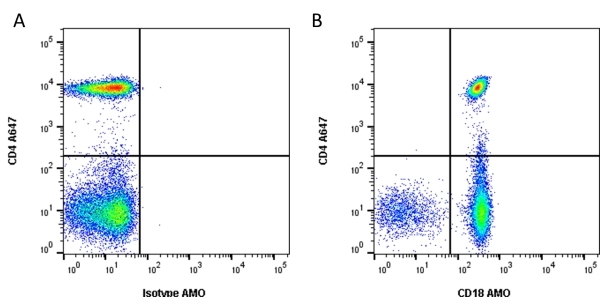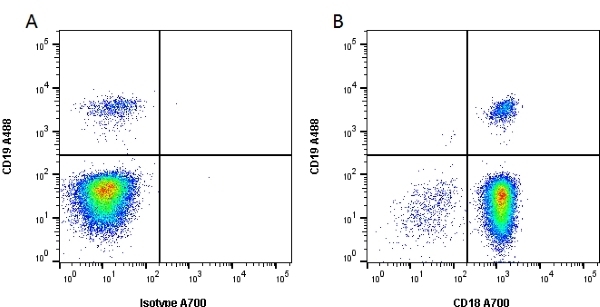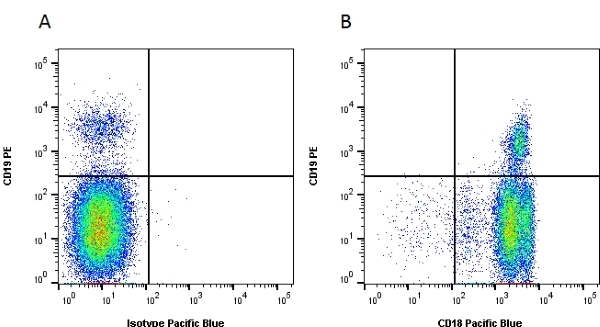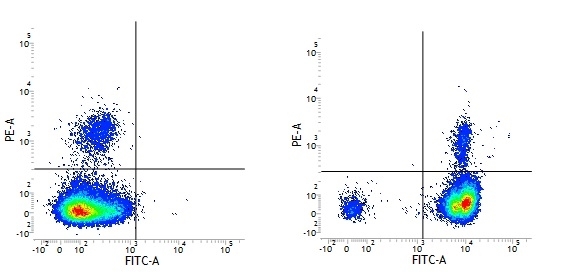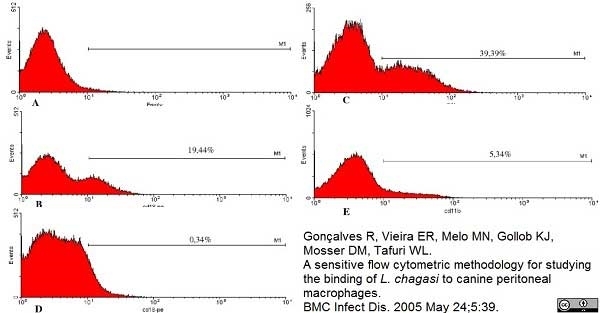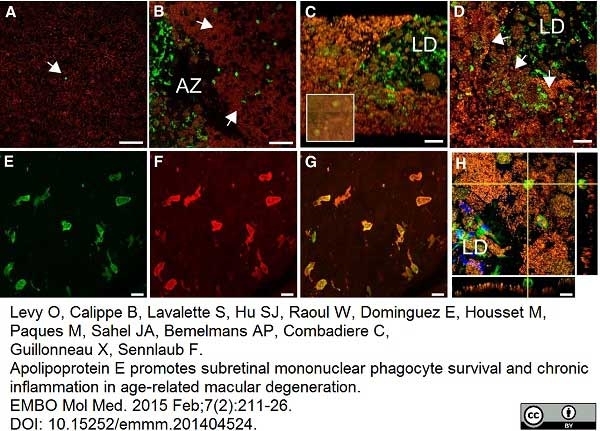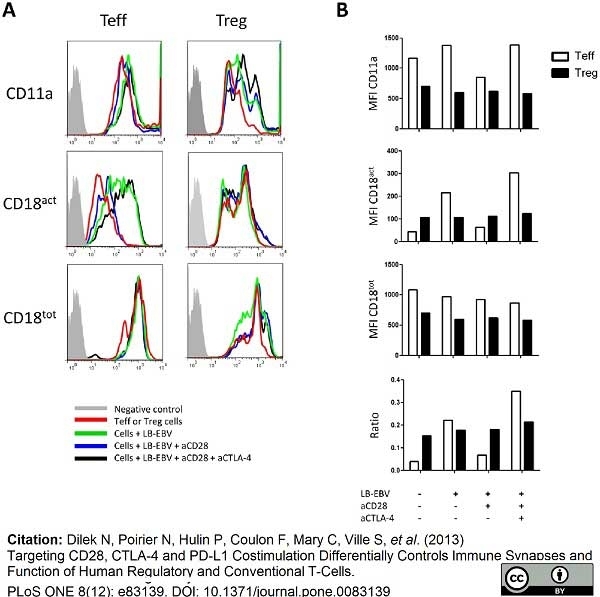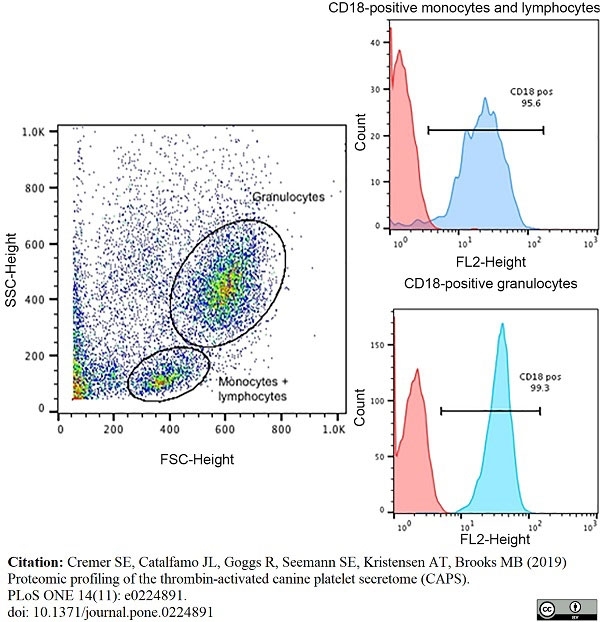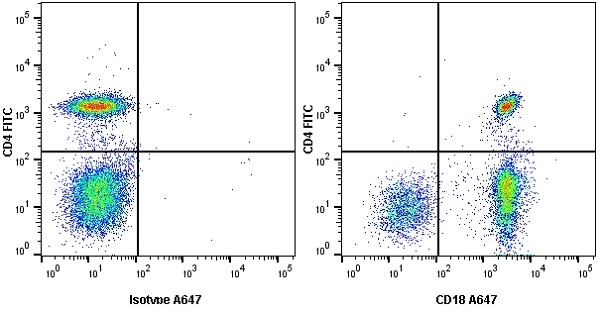CD18 antibody | YFC118.3









Rat anti Human CD18
- Product Type
- Monoclonal Antibody
- Clone
- YFC118.3
- Isotype
- IgG2b
- Specificity
- CD18
| Rat anti Human CD18 antibody, clone YFC118.3 was clustered at the Fourth International Workshop on Leucocyte Differentiation Antigens (code number N221) as recognizing the CD18 antigen. CD18 is an integral membrane glycoprotein of ~95 kDa, also known as the beta 2 chain, of the LFA-1 complex. CD18 links non-covalently to either CD11a, b or c molecules forming the heteromeric LFA-1 complex. CD18 acts as the receptor for ICAM-1 and is important for cell adhesion and cell-cell interactions (Reina &Espel 2017). Rat anti Human CD18 antibody, clone YFC118.3 demonstrates strong reactivity with leucocytes and is not reactive with platelets. |
- Target Species
- Human
- Species Cross-Reactivity
-
Target Species Cross Reactivity Dog Guinea Pig - N.B. Antibody reactivity and working conditions may vary between species.
- Product Form
- Purified IgG - liquid
- Preparation
- Antibody purified from tissue culture supernatant
- Buffer Solution
- Phosphate buffered saline
- Preservative Stabilisers
0.09% Sodium Azide - Carrier Free
- Yes
- Immunogen
- Human neutrophils
- Approx. Protein Concentrations
- IgG concentration 1 mg/ml
- Fusion Partners
- Spleen cells from immunized LOU rats were fused with cells of the rat Y3/Ag.1.2.3 myeloma cell line
- Regulatory
- For research purposes only
- Guarantee
- 12 months from date of despatch
Avoid repeated freezing and thawing as this may denature the antibody. Storage in frost-free freezers is not recommended.
| Application Name | Verified | Min Dilution | Max Dilution |
|---|---|---|---|
| Flow Cytometry | 1/50 | 1/100 | |
| Immunofluorescence | |||
| Immunohistology - Frozen 1 | 1/1000 | 1/5000 | |
| Immunohistology - Paraffin | |||
| Immunoprecipitation |
- 1The epitope recognised by this antibody is reported to be sensitive to formaldehyde fixation and tissue processing. Bio-Rad recommends the use of acetone fixation for frozen sections.
- Flow Cytometry
- Use 10ul of the suggested working dilution to label 106 cells in 100ul.
- Histology Positive Control Tissue
- Human Tonsil
| Description | Product Code | Applications | Pack Size | List Price | Your Price | Quantity | |
|---|---|---|---|---|---|---|---|
| Rat IgG2b Negative Control | MCA6006GA | F | 0.1 mg |
|
Log in | ||
| List Price | Your Price | ||||||
|
|
Log in | ||||||
| Description | Rat IgG2b Negative Control | ||||||
References for CD18 antibody
-
Bindon, C.I. et al. (1988) Importance of antigen specificity for complement-mediated lysis by monoclonal antibodies.
Eur J Immunol. 18 (10): 1507-14. -
Chabanne, L. et al. (1994) Screening of 78 monoclonal antibodies directed against human leukocyte antigens for cross-reactivity with surface markers on canine lymphocytes.
Tissue Antigens. 43 (3): 202-5. -
Mizuno, T. et al. (1997) cDNA cloning and chromosomal localization of the human telencephalin and its distinctive interaction with lymphocyte function-associated antigen-1.
J Biol Chem. 272: 1156-63. -
Kupatt, C. et al. (1999) Tumor necrosis factor-alpha contributes to ischemia- and reperfusion-induced endothelial activation in isolated hearts.
Circ Res. 84: 392-400. -
Salvatierra, A. et al. (2001) Antithrombin III prevents early pulmonary dysfunction after lung transplantation in the dog.
Circulation. 104: 2975-80. -
Spring, F.A. et al. (2001) Intercellular adhesion molecule-4 binds alpha(4)beta(1) and alpha(V)-family integrins through novel integrin-binding mechanisms.
Blood. 98: 458-66. -
Garland, R.J. et al. (2002) Human CD8+ CTL recognition and in vitro lysis of herpes simplex virus-infected cells by a non-MHC restricted mechanism.
Scand J Immunol. 55: 61-9. -
Gonçalves, R. et al. (2005) A sensitive flow cytometric methodology for studying the binding of L. chagasi to canine peritoneal macrophages.
BMC Infect Dis. 5:39.
View The Latest Product References
-
Alex, J. et al. (2005) Pretreatment with hyperbaric oxygen and its effect on neuropsychometric dysfunction and systemic inflammatory response after cardiopulmonary bypass: a prospective randomized double-blind trial.
J Thorac Cardiovasc Surg. 130: 1623-30. -
Lana, S. et al. (2006) Diagnosis of mediastinal masses in dogs by flow cytometry.
J Vet Intern Med. 20: 1161-5. -
Grote, K. et al. (2007) The angiogenic factor CCN1 promotes adhesion and migration of circulating CD34+ progenitor cells: potential role in angiogenesis and endothelial regeneration.
Blood. 110: 877-85. -
Sampaio, W.M. et al. (2007) In vitro binding and survival assays of Leishmania parasites to peripherical blood monocytes and monocyte-derived macrophages isolated from dogs naturally and experimentally infected with Leishmania chagasi.
BMC Vet Res. 3:11. -
Crosby, H.A. et al. (2009) Adhesion of human haematopoietic (CD34+) stem cells to human liver compartments is integrin and CD44 dependent and modulated by CXCR3 and CXCR4.
J Hepatol. 51: 734-49. -
Waché, Y.J. et al. (2009) The mycotoxin deoxynivalenol inhibits the cell surface expression of activation markers in human macrophages.
Toxicology. 262: 239-44. -
Holst, B.S. et al. (2010) Expression of four canine leukocyte adhesion factors in fresh and stored whole blood samples evaluated using a no-lyse, no-wash method.
Vet Immunol Immunopathol. 139: 271-6. -
Araújo, M.S. et al. (2011) Immunological changes in canine peripheral blood leukocytes triggered by immunization with first or second generation vaccines against canine visceral leishmaniasis.
Vet Immunol Immunopathol. 141: 64-75. -
Canalli, A.A. et al. (2011) Participation of Mac-1, LFA-1 and VLA-4 integrins in the in vitro adhesion of sickle cell disease neutrophils to endothelial layers, and reversal of adhesion by simvastatin.
Haematologica. 96: 526-33. -
Zimmerman, K.L. et al. (2013) Leukocyte adhesion deficiency type I in a mixed-breed dog.
J Vet Diagn Invest. 25: 291-6. -
Levy, O. et al. (2015) Apolipoprotein E promotes subretinal mononuclear phagocyte survival and chronic inflammation in age-related macular degeneration.
EMBO Mol Med. pii: e201404524. -
Sutcliffe, J.E.S. et al. (2017) Changes in the extracellular matrix surrounding human chronic wounds revealed by 2-photon imaging.
Int Wound J. Jul 20 [Epub ahead of print]. -
Cremer, S.E. et al. (2019) Proteomic profiling of the thrombin-activated canine platelet secretome (CAPS).
PLoS One. 14 (11): e0224891. -
Wolf-Ringwall, A. et al. (2020) Prospective evaluation of flow cytometric characteristics, histopathologic diagnosis and clinical outcome in dogs with naïve B-cell lymphoma treated with a 19-week CHOP protocol.
Vet Comp Oncol. 18 (3): 342-52. -
Sheng, R. et al. (2023) Prognostic significance of CD25 expression in dogs with a noninvasive diagnosis of B-cell lymphoma treated with CHOP chemotherapy.
Vet Comp Oncol. 21 (1): 28-35.
Further Reading
-
Marconato, L. (2013) The dog as a possible animal model for human non-Hodgkin lymphoma: a review.
Hematol Oncol. 31: 1-9.
- Synonyms
- Integrin Beta 2 Chain
- RRID
- AB_321325
- UniProt
- P05107
- Entrez Gene
- ITGB2
- GO Terms
- GO:0001948 glycoprotein binding
- GO:0007596 blood coagulation
- GO:0006915 apoptosis
- GO:0004872 receptor activity
- GO:0008305 integrin complex
- GO:0006954 inflammatory response
- GO:0007159 leukocyte cell-cell adhesion
- GO:0007160 cell-matrix adhesion
- GO:0007229 integrin-mediated signaling pathway
- View More GO Terms
- GO:0007267 cell-cell signaling
- GO:0007275 multicellular organismal development
- GO:0008360 regulation of cell shape
- GO:0019901 protein kinase binding
- GO:0030593 neutrophil chemotaxis
- GO:0050730 regulation of peptidyl-tyrosine phosphorylation
- GO:0050776 regulation of immune response
Please Note: All Products are "FOR RESEARCH PURPOSES ONLY"
View all Anti-Human ProductsAlways be the first to know.
When we launch new products and resources to help you achieve more in the lab.
Yes, sign me up